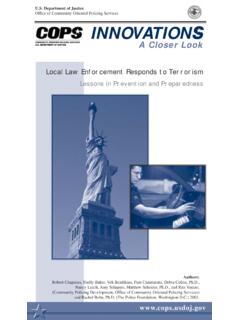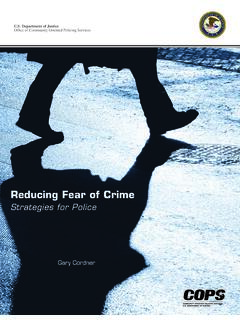Transcription of A Performance-Based Approach to Police Staffing and …
1 A Performance-Based Approach TO Police Staffing AND ALLOCATIONJ eremy M. Wilson and Alexander WeissA Performance-Based Approach TO Police Staffing AND ALLOCATIONJ eremy M. Wilson and Alexander WeissThis project was supported by Grant Number 2009-CK-WX-K005 awarded by the Office of Community Oriented policing Services, Department of Justice. The opinions contained herein are those of the author(s) and do not necessarily represent the official position or policies of the Department of Justice. References to specific agencies, companies, products, or services should not be considered an endorsement by the author(s) or the Department of Justice. Rather, the references are illustrations to supplement discussion of the issues. The Internet references cited in this publication were valid as of the date of this publication.
2 Given that URLs and websites are in constant flux, neither the author(s) nor the COPS Office can vouch for their current validity. Recommended citation: Wilson, Jeremy M., and Alexander Weiss. 2014. A Performance-Based Approach to Police Staffing and Allocation. Washington, DC: Office of Community Oriented policing 978-1-932582-60-4 First printed 2012 Revised 2014 iii About the COPS OfficeThe Office of Community Oriented policing Services (COPS Office) is the component of the Department of Justice responsible for advancing the practice of community policing by the nation s state, local, territory, and tribal law enforcement agencies through information and grant resources. Community policing is a philosophy that promotes organizational strategies that support the systematic use of partnerships and problem-solving techniques, to proactively address the immediate conditions that give rise to public safety issues such as crime, social disorder, and fear of crime.
3 Rather than simply responding to crimes once they have been committed, community policing concentrates on preventing crime and eliminating the atmosphere of fear it creates. Earning the trust of the community and making those individuals stakeholders in their own safety enables law enforcement to better understand and address both the needs of the community and the factors that contribute to COPS Office awards grants to state, local, territory, and tribal law enforcement agencies to hire and train community policing professionals, acquire and deploy cutting-edge crime fighting technologies, and develop and test innovative policing strategies. COPS Office funding also provides training and technical assistance to community members and local government leaders and all levels of law enforcement.
4 The COPS Office has produced and compiled a broad range of information resources that can help law enforcement better address specific crime and operational issues, and help community leaders better understand how to work cooperatively with their law enforcement agency to reduce crime. Since 1994, the COPS Office has invested nearly $14 billion to add community policing officers to the nation s streets, enhance crime fighting technology, support crime prevention initiatives, and provide training and technical assistance to help advance community policing . To date, the COPS Office has funded approximately 125,000 additional officers to more than 13,000 of the nation s 18,000 law enforcement agencies across the country in small and large jurisdictions alike. Nearly 700,000 law enforcement personnel, community members, and government leaders have been trained through COPS Office-funded training organizations.
5 To date, the COPS Office has distributed more than million topic-specific publications, training curricula, white papers, and resource CDs. COPS Office resources, covering a wide breadth of community policing topics from school and campus safety to gang violence are available, at no cost, through its online Resource Center at This easy-to-navigate website is also the grant application portal, providing access to online application forms. v ContentsAbout the COPS Office ..iiiPreface ..1 CHAPTER ONE ..2 Introduction ..3 Objective ..3 Approach ..4 Outline of Guide ..6 CHAPTER TWO ..8 Charting the Staffing Landscape ..9 The Profound Effect of the 2008 Recession on Staffing ..10A Wide Range of Internal and External Factors Determine Staffing Need ..11 Agencies Perform Staffing Analyses to Varying Degrees.
6 12 Budgeting for Staffing is Precarious ..13 Agencies Feel Understaffed, But Cannot Demonstrate It ..14 Context Matters When Considering Staffing Analysis ..15 Community policing and Problem-Solving Efforts Are Being Compromised ..15 Salient Themes Emerge from Staffing Experiences ..16 Agencies Are Adjusting to a New Normal ..17 Agencies Seek Efficient Ways to Do Business ..17 Staffing Analysis Remains a Mystery to Many ..17 Staffing Analyses Are Useful but Out of Reach ..17 Staffing Is an Intuitive Process ..18 Concluding Remarks ..18 CHAPTER THREE ..20A Workload-Based Assessment for Patrol ..21 Typical Approaches to Staffing Allocation ..21 The Per Capita Approach ..22 The Minimum Staffing Approach ..24 The Authorized Level Approach ..26 The Workload-Based Approach .
7 27A Performance-Based Approach TO Police Staffing AND ALLOCATION vi A Performance-Based Approach TO Police Staffing AND ALLOCATIONA Step-By-Step Approach for Conducting a Workload-Based Assessment ..28 Examine the Distribution of Calls for Service by Hour of Day, Day of Week, and Month ..29 Examine the Nature of Calls for Service ..30 Estimate Time Consumed on Calls for Service ..31 Calculate Agency Shift-Relief Factor ..32 Establish Performance Objectives ..35 Provide Staffing Estimates ..37 Limitations of the Workload-Based Model ..43 Work Schedule ..44 Eight-Hour Shifts ..45 Ten-Hour Shifts ..47 Twelve-Hour Shifts ..48 Concluding Remarks .. 50 CHAPTER FOUR .. 52 Alternative Delivery Systems ..53 Mobilizing the Police ..54 Handling Reports ..56 Non-Sworn Staff.
8 58 Concluding Remarks .. 59 CHAPTER FIVE ..60 Staffing for Community policing ..61 Basic Approaches to Community policing Implementation ..62 Implications of Community policing for Staffing ..63 Maximizing the Discretionary Time of Patrol Officers ..64 Creating a Special Unit ..64 Future Directions ..66 References ..67 About the Authors ..74A Performance-Based Approach TO Police Staffing AND ALLOCATIONA Performance-Based Approach TO Police Staffing AND ALLOCATION 1 PrefaceMuch attention has been given to Police recruitment, retention, and, in this economic context, how to maintain Police budgets and existing Staffing positions. Less has centered on adequately assessing the demand for Police service and alternative ways of managing that demand . To provide some practical guidance in these areas, the Office of Community Oriented policing Services (COPS Office) provided support to the Michigan State University (MSU) School of Criminal Justice to review current Staffing allocation experiences and existing approaches to estimating the number of sworn staff a given agency requires.
9 This guide summarizes the research conducted by the MSU team. It highlights the current Staffing allocation landscape for law enforcement agencies and provides a practical step-by-step Approach for any agency to assess its own patrol Staffing needs based upon its workload and performance objectives. Additionally, it identifies some ways beyond the use of sworn staff that workload demand can be managed and discusses how an agency s Approach to community policing implementation can affect Staffing allocation and deployment. This guide will be particularly useful for Police practitioners and planners conducting an assessment of their agency s Staffing need and for researchers interested in Police Staffing experiences and assessment methods. This guide has a companion document, titled Essentials for Leaders: A Performance-Based Approach to Police Staffing and Allocation, which may be of particular interest to Police executives and policymakers who are concerned about both Police - Staffing allocation and efficiently providing quality Police service in their communities.
10 CHAPTER ONECHAPTER ONE 3 IntroductionStaffing Police departments is a continuous challenge and one that has become more complex in recent years. Immediately prior to the onset of the 2008 recession, Police agencies had difficulty recruiting officers and responded by implementing a number of creative recruitment incentives. Shortly thereafter, the depressed economy caused Police agencies to implement hiring freezes, furloughs, lay-offs, salary and benefit cut-backs, and retirement incentives. Such difficulties spurred 7,272 applications to the COPS Hiring Program requesting $ billion to support more than 39,000 sworn-officer positions (COPS Office 2009). Altogether, both the supply of and demand for qualified officers are changing in a time of increasing attrition, expanding law-enforcement responsibilities, and decreasing resources (Wilson, Dalton, Scheer, and Grammich 2011).









